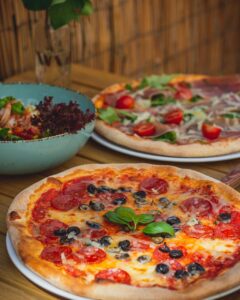The 7 Most Profitable Restaurant Foods and Insights into the Restaurant Business
Running a profitable restaurant is a complex and challenging task, requiring culinary expertise and a keen understanding of restaurant business economics. The food you serve plays a significant role in your restaurant’s profitability, with some menu items offering higher profit margins than others. In this article, we explore the seven most profitable restaurant foods, critical factors in restaurant profitability, and essential insights to help restaurant owners navigate the challenges of the industry. These dishes are not only profitable but also in high demand, reassuring you that your menu choices are on the right track.

-
Burgers: The Everlasting Favourite
Burgers are a classic and a staple in many restaurants worldwide. From fast-food chains to high-end gourmet establishments, burgers remain one of the most profitable restaurant foods for several reasons. First, the cost of ingredients—such as beef, lettuce, cheese, and bread—can be relatively low, especially when purchased in bulk. Additionally, the simple preparation and fast cooking time allow for a quick turnaround, enabling restaurants to serve a high volume of customers.
The versatility of burgers also contributes to their profitability. Restaurants can charge a premium for gourmet options, adding unique toppings, sauces, or premium ingredients like truffle oil or artisanal cheeses. This allows for flexible pricing while still maintaining a high profit margin. Inexpensive ingredients, quick preparation, and mass appeal make burgers a winner in the restaurant business.
-
Pizza: The Ultimate Crowd Pleaser
Pizza is another menu item with significant profit potential and one of the most profitable restaurant foods to sell. Examples such as burgers, pizza’s profitability stems from its low-cost ingredients and high demand. Dough, cheese, and sauce are the basic components of any pizza, all of which can be sourced affordably. The beauty of pizza lies in its flexibility—restaurants can offer a range of pizzas from basic Margherita to gourmet options with exotic toppings.
Pizza also has a relatively long shelf life compared to other fresh foods, reducing waste and increasing the restaurant’s bottom line. Moreover, pizza travels well for delivery, making it an ideal item for restaurants with a takeaway or delivery service. A pizzeria can operate with lower overhead costs and still generate high profits due to the scalability of pizza production. This means that once the initial preparation is done, additional pizzas can be made quickly and easily, allowing for a high volume of sales with minimal additional effort.

-
Pasta Dishes: Low Cost, High Margin
Pasta is another profitable food option for restaurants due to its low cost of production and high mark-up potential. The basic ingredients—flour, water, and eggs—are inexpensive, and pasta can be prepared in large quantities with minimal effort. Sauces, vegetables, and proteins like chicken or seafood are often the primary cost drivers, but even these can be managed to maintain profitability. For instance, using seasonal vegetables and buying in bulk can help reduce costs. Additionally, using smaller portions of expensive proteins and balancing them with more affordable options can help maintain a high-profit margin.
Additionally, pasta is highly versatile. A simple dish like spaghetti with marinara sauce can be sold for a modest price. In contrast, more elaborate dishes like seafood linguine or truffle gnocchi can command a much higher price, further boosting profit margins. Pasta’s universal appeal and easy preparation make it a go-to choice for restaurants looking to optimize their profitability.
-
Sandwiches: A Profitable Staple
Sandwiches are another menu item with a high-profit margin. The ingredients required—bread, meats, cheeses, vegetables—are generally low-cost, and sandwiches are quick to assemble, reducing labour costs. Burgers and sandwiches are popular menu items in restaurants due to their high level of customisation, to meet a wide variety of needs, tastes and dietary requirements.
Many restaurants capitalise on the growing trend of gourmet sandwiches, offering options with premium ingredients like smoked salmon, avocado, or artisanal bread. These gourmet options can be priced significantly higher than traditional sandwiches, providing an opportunity for greater profit while still using relatively inexpensive base ingredients.
Unlock The Secret of Restaurant Gross Profit Margin Analysis
-
Vegetables and Vegetarian Dishes: Profitable and Trendy
Vegetarian and plant-based dishes are trending and highly profitable for restaurants. The price of vegetables is typically significantly lower than that of animal-based proteins, and there is a rising demand for vegetarian and vegan choices. As more people adopt plant-based diets for health, ethical, or environmental reasons, restaurants can meet this demand while enjoying substantial profit margins.
Vegetarian dishes also allow chefs to get creative with presentation and flavours, offering unique dining experiences that can justify higher price points. From hearty salads to innovative plant-based entrees, vegetables are no longer relegated to side dishes; they are often the stars of the menu, and their profitability reflects this shift.
-
Soups and Stews: Comfort Food with a High Return
Soups and stews are among a restaurant’s most cost-effective menu items. The ingredients—often vegetables, grains, and inexpensive cuts of meat—are usually low-cost, and these dishes can be made in large batches. The slow-cooking process enhances the flavours, transforming simple ingredients into flavourful, satisfying meals.
Because soups and stews can be made in bulk, they reduce kitchen labour and prep time, further contributing to their profitability. These dishes often have a long shelf life, meaning they can be stored and served over several days, minimising food waste. The simplicity and comfort of soups and stews make them an appealing option for customers and restaurant owners alike.
-
Fried Foods: Quick, Easy, and Profitable
Fried foods like chicken wings, fries, and onion rings are consistently popular, relatively cheap, and easy to produce. The ingredients are usually inexpensive, and frying is a quick cooking method, allowing for rapid service. Fried foods are also in high demand, particularly in fast-casual or takeout settings, where customers are looking for quick, tasty options.
One key advantage of fried foods is their high mark-up potential. For example, a portion of fries that costs a restaurant a few pence to make can be sold for several Pounds. This makes fried foods attractive for restaurants seeking to increase their profit margins.

Understanding Restaurant Profitability: How Long Does It Take?
While having a menu with high-profit items is essential, it’s important to understand that restaurant profitability is influenced by various factors beyond just the food served. Typically, it takes an average of two years for a new restaurant to become profitable. The amount of time needed can differ based on how large the restaurant is, its location, concept and the overall economic climate.
During the first few years, restaurants often need help with cash flow, as initial investments and operational costs can be high. The failure rate for new restaurants is notoriously high, often due to insufficient funding or poor planning. Proper financial management, effective marketing, and menu optimization are crucial to weathering the challenging early years.
Fine Dining and Small Portions: The Economics of Gourmet Meals
Why do fine dining establishments often serve smaller portions despite charging higher prices? The answer lies in the economics and philosophy behind fine dining. Smaller portions allow chefs to use premium ingredients more efficiently, reducing waste and managing costs. By minimising excess food production, restaurants can lower their expenses and create artfully designed dishes focusing on quality rather than quantity.
Additionally, small portions are often part of the fine dining experience, where presentation, taste, and creativity are emphasised over the size of the meal. This approach also aligns with sustainability efforts, as less food waste contributes to a lower environmental impact.
Restaurant Profits: How To Increase Sales To Skyrocket You Profits
Profit Margins and the Life Cycle of a Restaurant
The typical restaurant profit margin is 2% to 6%, depending on factors such as location, restaurant types, and the cost of operating the unit. To break it down further, one-third of a restaurant’s revenue is usually allocated to the cost of goods sold (COGS), another to labour costs, and the remaining revenue goes toward overhead expenses such as rent and utilities.
Despite the slim profit margins, restaurants that manage their costs effectively can enjoy long-term success. The average lifespan of a restaurant is eight to ten years, though many factors, including competition, customer preferences, and economic shifts, can impact this.
Increasing Profit Margins: 5 Key Strategies
- Menu Optimization: Regularly analyse the profitability of menu items and adjust pricing or ingredients to improve margins.
- Inventory Management: Efficiently manage inventory to reduce waste and avoid over-purchasing.
- Staff Training: Train staff to improve efficiency and minimise errors, which can reduce labour costs.
- Technology Integration: Implement technology like POS systems to streamline operations and reduce manual errors.
- Cost Control: To maximise profitability, monitor fixed and variable costs, from utilities to ingredient sourcing.
Conclusion
Running a profitable restaurant involves more than just serving good food; it requires careful planning, cost control, and menu optimization. By focusing most profitable restaurant foods with high-margin items such as burgers, pizza, and pasta, restaurants can increase their profitability while catering to customer demand. While the path to success may be challenging, restaurants can thrive in a competitive market with the right strategies.
Related articles:
Energy Saving Tips For Restaurant Owners
How To Increase Restaurant Profits
How To Manage A Restaurant Finances
FAQ’s
What is the most profitable restaurant concept?
The most profitable restaurant concept typically revolves around fast-casual dining. This concept blends the convenience of fast food with the quality of sit-down dining, allowing for quicker turnover, lower labour costs, and a simplified menu. Fast-casual restaurants often focus strongly on efficient operations, low-cost ingredients, and healthy or trendy food options, which resonate well with modern consumers. Other most profitable restaurant food concepts include food trucks, pizza restaurants, and gourmet burger joints, as they offer high demand, low overhead, and scalable menu options.
What is the key to the success of a restaurant?
The key to a restaurant’s success lies in several factors:
- Menu Optimization: Offering high-margin dishes that meet customer preferences and dietary trends.
- Excellent Customer Service: Providing a great dining experience that encourages repeat business.
- Cost Management: Efficient control of food costs, labour, and overhead.
- Location and Ambience: Choose a prime location with high foot traffic and create a welcoming environment.
- Marketing and Branding: Using social media, promotions, and loyalty programs effectively can help in both attracting new customers and retaining existing ones. Consistency, quality, and adapting to changing trends are also crucial for long-term success.
What is the most profitable food to sell?
Some of the most profitable foods to sell in restaurants include:
- Burgers: Low-cost ingredients are in high demand, and there is potential for customization with gourmet options.
- Pizza: Low-cost base ingredients like dough and cheese with scalable preparation and high markup potential.
- Pasta: Inexpensive to make and can be sold at a premium, especially with high-end ingredients.
- Fried Foods: Items like fries and chicken wings are inexpensive and popular, with high-profit margins.
- Vegetarian Dishes: With increasing demand for plant-based options, vegetables are low-cost and can be sold at competitive prices.
How can a restaurant increase profitability?
A restaurant can increase profitability through the following strategies:
- Menu Engineering: Focus on high-margin items and regularly analyze the most profitable dishes.
- Inventory Management: Efficiently track inventory to reduce waste and over-purchasing.
- Portion Control: Ensure that portions are controlled to avoid excess costs and food waste.
- Technology Integration: Use technology like POS systems to streamline ordering, reduce human error, and track data for decision-making.
- Cost Control: Monitor both fixed and variable costs closely, including utilities, rent, and labour.
- Marketing: Implement targeted marketing strategies to drive customer traffic, increase brand visibility, and promote profitable menu items.


